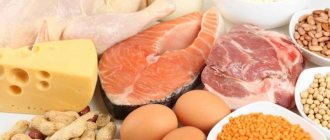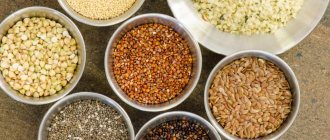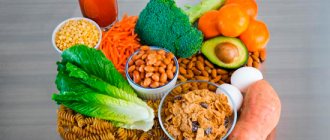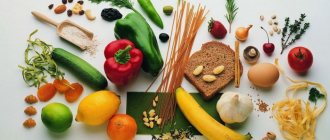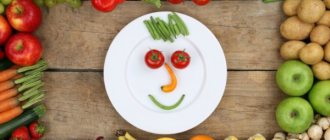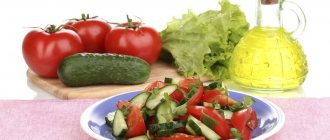Carbohydrates are considered to be important components of the daily diet that tone the human body. A lack of these substances leads to fatigue and drowsiness, dizziness, and even, with prolonged deficiency, the development of certain diseases.
[no_toc]
- Quick navigation through the article:
- Slow carbohydrates
- The importance of carbohydrates
- Carbohydrates that make you fat
- Sources and types of carbohydrates
- Carbohydrates for weight loss
- Table of foods with carbohydrates
- Top 5 recipes
- Glycemic diet
- Daily norm
- Balanced diet
- Reviews
Doctors are confident that slow carbohydrates have great benefits for the body.
A list of products, a table for weight loss, breakfast recipes - all this will help you create the right diet to keep your body in good shape and get rid of extra pounds.
Slow carbohydrates - substances necessary for daily consumption
Carbohydrates consist of “units” (saccharides), and the presence of more than three saccharides by chemical composition includes them in the group of polysaccharides.
A list of products, a table for weight loss, breakfast recipes - all this will help you create the right diet to keep your body in good shape.
Slow carbohydrates contain the following monosaccharides.
Starch
In the gastrointestinal tract, it is gradually broken down by enzymes and maintains the concentration of glucose in the blood.
Glycogen
Without the participation of intermediate products, the substance is broken down into glucose. During a shortage of carbohydrates, the monosaccharide glycogen is produced from proteins as well as fats.
Cellulose
It is also a natural “cleaner”. Removing toxic substances, heavy metal salts, harmful cholesterol. The process occurs due to contraction of the intestinal walls. The breakdown of fiber stops rotting and blocks the development of diseases associated with the functioning of the intestines.
The breakdown of fiber stops rotting and blocks the development of diseases associated with the functioning of the intestines. Most of it is in porridges.
Insulin
It is considered a storage carbohydrate in some plants and is formed from fructose. It often functions as a sweetener, and in the body as a stabilizer. Contained only in ripe fruits.
So, complex carbohydrates are substances that improve the digestive system , normalize glucose concentrations and contain a high proportion of fiber. Regular consumption keeps you full for a long time and maintains energy reserves.
Experts say the best time to take slow carbohydrates is before 12 noon (breakfast and lunch), and for dinner it is advisable to create a diet with low-fat food, that is, protein.
Complex carbohydrates reduce calorie intake, which promotes weight loss.
The importance of slow carbohydrates during pregnancy
Slow carbohydrates during pregnancy
Complex saccharides perform the following functions:
- are an excellent source of energy;
- improve digestion and metabolic processes;
- normalize glucose levels;
- maintains normal weight;
- fight depression;
- have a beneficial effect on the condition of the skin and hair.
Their deficiency leads to a decrease in mental abilities, deterioration of concentration, problems with sleep, and negatively affects the condition of muscle tissue.
It is necessary to maintain the required amount of polysaccharides during pregnancy, as they normalize the functioning of the pancreas. It is especially important for women with endocrine system disorders, where there are problems with insulin production. Improves peristalsis and fights constipation.
An important function of slow carbohydrates is the fact that the body spends a lot of energy on their breakdown, which makes it possible to maintain normal weight. It is a supplier of vitamins and minerals that are essential for the normal development of the fetus.
How important are slow and complex carbohydrates when losing weight?
The simpler the composition of carbohydrates, the lower the amount of saccharides. This means that the body will digest them faster, and this will lead to an increase in sugar concentration.
The simpler the composition of carbohydrates, the lower the amount of saccharides. This means that the body will digest them faster, and this will lead to an increase in sugar concentration.
The absorption of carbohydrates of plant origin occurs a little slower , since the speed depends on the glycemic index. Products with a high glycemic index consist of more than a hundred structural elements combined with each other. This means that they are able to deliver energy to the body as quickly as possible.
Useful information about monosaccharides:
- Complex carbohydrates are found in cereals. In plants they are found in cellulose and starch;
- The complex molecular structure leads to low solubility of polysaccharides;
- Glycogen is the material for the functioning of muscles, systems and organs. Deposited in muscles, liver;
- During physical training, muscle glycogen is consumed;
- In people weighing 70 kg, the amount of glycogen after eating is 327 g;
- 80% of the nutritious diet and the total share of carbohydrates we consume per day is taken up by starch.
What are slow carbohydrates
These substances belong to polysaccharides.
When interacting with water, they form monosaccharides - simple sugars. In the body they perform structural, reserve and other functions. Many vital processes occur with their participation. The rate of conversion of saccharides is reflected by the glycemic index (GI).
A low rate means that the carbohydrate is absorbed gradually. There are several slow sugars:
- starch - gradually breaks down in the digestive tract without causing insulin surges;
- Glycogen is converted by the liver and serves as an energy reserve.
- fiber – partially digestible, stimulates increased secretion of bile, provides a feeling of satiety;
- inulin is a by-product of the breakdown of fructose and is used as a sweetener for diabetics.
Carbohydrates that make you fat
The benefits come from moderately cooked carbohydrates from plants and vegetables. Next come grains and cereals with an average GI.
Peeled grains (for example, rice, flour) are classified as neutral, but their excessive consumption leads to excess weight gain.
In answer to the question posed, it is worth noting the importance of two types of carbohydrates: with an excess of sugars, they are not completely deposited into glycogen.
The benefits come from moderately cooked carbohydrates from plants and vegetables. Next come grains and cereals with an average GI.
Excess leads to the conversion of sugars into triglycerides, which accelerate the development of adipose tissue. That is, regular consumption of carbohydrates will cleanse the body and reduce the amount of cholesterol.
Experts say that 50% of the daily food intake should be slow carbohydrates.
The list of products (the weight loss table shows the most frequently used products) is your healthy basket and it will help you correctly distribute your daily intake.
Research in the field of medicine has proven that under their influence the body's endurance increases , and fat burning occurs much faster and more efficiently.
Experts say that 50% of the daily food intake should be slow carbohydrates.
A few words about the glycemic index
The glycemic index displays information about how quickly consumed carbohydrates are absorbed and penetrate into the blood. The higher the indicator, the faster this process takes place, leading to weight gain. In addition, GI shows the rate of increase in blood glucose after eating. Glucose is used as the GI standard, the index of which is 100 units.
Today the following classification is used:
- GI is low (less than 50);
- GI is average if the indicator is between 50 and 70 units;
- GI is high if the indicator is more than 70.
The lower the glycemic index parameter, the more benefits the human body receives from the consumed product.
Sources and types of slow carbohydrates
A large amount of slow carbohydrates is found in the following foods:
- berries;
- starch;
- cereals;
- fruits;
- cereals (except semolina);
- vegetables (leeks, zucchini, tomatoes, avocados, cabbage and onions);
- legumes;
- wild rice;
- greenery;
- bread using wholemeal flour;
- mushrooms;
- pasta (durum wheat varieties).
The presence of an increased amount of monosaccharides, as well as 2 or 3 molecular chains, is an advantage of slow carbohydrates. We will present the list of products in the table for weight loss later, but now we will find out the types.
Table and list of foods with slow carbohydrates for weight loss
So, types of slow carbohydrates:
- starch;
- chitin is a natural compound, a group of polysaccharides;
- glucomannan is a dietary supplement obtained from the root of Amorphophallus konjac;
- dextrin is a polysaccharide. It is obtained as a result of heat treatment of two types of starch: potato and corn;
- glycogen;
- Cellulose is an insoluble carbohydrate.
Sources of slow carbohydrates.
Due to excess monosaccharides, the process of breakdown, energy release and absorption occurs very slowly.
Foods with a glycemic index below 50
Carbohydrate-containing foods with a low GI (below 50) are even more welcome on the table.
They can be used daily without any twinge of conscience; they will only bring benefits:
- Brown rice
- bran bread
- beans
- durum flour pasta
- pears
- carrot
- dried apricots
- strawberry
- apples
- peaches
- cherry
- grapefruit
- pepper
- tomatoes
- mushrooms
- cabbage
- soybeans
- peas
- milk
In contrast to slow carbohydrates, simple carbohydrates are harmful foods for our body. They are small sugar molecules that are absorbed incredibly quickly by our bodies. Initially, energy is stored in the form of glycogen, gradually being replaced by fat in the cells of the human body.
The proportion of carbohydrates on the table should be 50%
It is recommended to exclude or limit their consumption if possible:
- candies and desserts
- sweet carbonated drinks
- baked goods such as buns and white bread
- sweet cereals
- anything that contains a lot of sugar in its composition
Complex carbohydrates for weight loss (porridge diets)
The diet is based on the daily consumption of cereal porridges, except semolina. The benefits of morning meals lie in the beneficial effects of fiber, which helps cleanse the intestines.
The fitness industry offers you to choose one of two options: a 10-day diet and a 7-day diet. The effect of each will be visible only by following certain rules.
"6 porridges"
Every day you eat porridge from any cereal. On the last day, repeat any dish you wish or prepare porridge from several cereals. The amount of consumption is not limited, since cereals are rich in slow carbohydrates.
The list of foods (the weight loss table indicates their GI) is varied, so choosing additional ingredients to sweeten porridges is not difficult.
They need to be boiled in unsalted water. A couple of days before the diet, exclude fast foods, spicy foods, alcohol and fried foods.
The diet is based on the daily consumption of cereal porridges, except semolina.
Diet "10 days"
Exclude potatoes, butter, all types of dairy products, bread, meat, fish, baked goods, and poultry from your diet. On diet days we eat porridge without salt. Before eating, be sure to drink a glass of water.
During every diet, it is permissible to sweeten food with honey, fruits and nuts. Frequency: once every 6 months. The solution is achieved by gradually adding prohibited goods.
Fast carbohydrates (food table)
The list of fast carbohydrates includes foods of plant origin that, after purification, processing or cooking, do not contain fiber, but have a high concentration of starch or added sugar.
| Product | GI | Carbohydrate content per 100 grams, g |
| Flour products | ||
| White bread made from premium flour | 95 | 49 |
| Bagels | 70 | 57,1 |
| Buns | 85 | 49,7 |
| Pancakes | 75 | 28,2 |
| Crackers | 80 | 57,9 |
| Rice noodles | 92 | 74,9 |
| Pasta from soft wheat varieties | 70 | 45 |
| Cereal dishes | ||
| Semolina porridge on water | 94 | 18,9 |
| Semolina porridge with milk | 100 | 23 |
| Oat flakes on water | 80 | 58 |
| Oatmeal with milk | 89 | 65 |
| White rice porridge | 90 | 25,7 |
| Corn porridge | 85 | 30,3 |
| Millet porridge | 71 | 24 |
| Muesli | 69 | 61,4 |
| Popcorn | 85 | 57,7 |
| Cooked vegetables | ||
| Potato | 87 | 16,3 |
| Beet | 80 | 10,5 |
| Zucchini | 75 | 7,3 |
| Carrot | 85 | 5,3 |
| Pumpkin | 75 | 6,4 |
| Chips | 90 | 53 |
| Fried potatoes | 95 | 22,5 |
| Fruits | ||
| Grape | 70 | 17,5 |
| Bananas | 89 | 21,6 |
| Watermelon | 72 | 8,3 |
| Melon | 66 | 7,4 |
| Canned apricot | 91 | 17 |
| Dried fruits | ||
| Raisin | 65 | 70,9 |
| Dates | 143 | 69,2 |
| Dessert | ||
| Black chocolate 58% | 70 | 45 |
| Milk chocolate | 69,5 | 54,4 |
| Chocolate white | 75 | 62,2 |
| Honey | 90 | 80,3 |
| Marshmallow | 65 | 79,8 |
| Halva | 80 | 54 |
| Ice cream | 60 | 20 |
| Cookie | 57 | 80 |
| Condensed milk | 61 | 55,5 |
| Beverages | ||
| Sweet carbonated drinks | 70 | 8,7 |
| Packaged juice | 72 | 10,2 |
| Beer (dark) | 110 | 2,9 |
Table: list of foods with slow carbohydrates
The smooth functioning of the body lies in constant saturation with slow carbohydrates. The ideal ratio is 2:3. This means you need to eat 300 grams. fruits and vegetables 450 gr.
Let us consider in detail the daily consumed food products containing slow carbohydrates. The list of foods (weight loss table below) includes GI and sources.
The smooth functioning of the body lies in constant saturation with slow carbohydrates.
Top 5 healthy breakfast recipes
Slow carbohydrates are not stored in the waistline and this is a good reason to start the day with them.
Ideal breakfast options:
- Mix of cereals. You can cook rolled oats or steam buckwheat overnight. But it’s best to treat yourself to porridge made from a mixture of cereals. Sweeten the dish with fruit, honey or dried fruits.
- Vegetable and cheese sandwiches. Of course, a hot sandwich is hard to eat in the morning, so start the day with a vegetable one. Use whole grain bread. Top with a slice of cheese, lettuce, cucumber, tomato ring and a sprig of herbs.
- Vegetable Salad. For cooking, anything from the refrigerator is suitable, but you only need to season it with vegetable oil. You can complement your “green” breakfast with a boiled egg.
- Vegetable omelette or scrambled eggs. According to nutritionists, a little protein won't hurt. Use fresh vegetables when in season. In winter, you can replace them with frozen ones.
- Fruits. Can also be consumed as a salad. Season with low-fat yogurt, but it is better to leave the chopped fruit for 15 minutes so that they release their juice.
Mix of cereals. You can cook rolled oats or steam buckwheat overnight. But it’s best to treat yourself to porridge made from a mixture of cereals. Sweeten the dish with fruit, honey or dried fruits.
Morning drinks can be anything, the main thing is not to drink breakfast with them. Before eating, it won't hurt to drink a glass of water to start the digestive system.
Glycemic diet: the path to beauty and health of the body
To achieve the best effect from following a diet, you need to study the weight loss table, which contains a list of foods with slow carbohydrates and GI.
The diet is divided into 3 stages:
- Inclusion in the diet of products with a GI of up to 39;
- Phased introduction of food products with a GI from 40 to 59;
- 2/3 of the diet consists of products with GI values up to 39, the remaining 1/3 is with high GI.
Conditions for following the diet:
- The norm of consumed calories per day is 1400-1500. A deviation of a hundred kcal is possible;
- Drinks that are allowed include herbal teas, low-fat milk, yogurt and water;
- exclude flour, sweet products and fatty foods.
The norm of calories consumed per day is 1400-1500. A deviation of a hundred kcal is possible.
Sample daily menu:
- Breakfast. Buckwheat or oatmeal brewed with boiling water, milk, apple.
- Snack. A few pears or a salad of cucumbers and stalk celery.
- Dinner. Cereal soup with vegetable broth, a piece of rye bread, a few plums.
- Snack. A glass of curdled milk or 100 gr. cottage cheese.
- Dinner. Chicken stew with beans, tomatoes and onions.
Fast and slow carbohydrates - what's the difference?
Carbohydrates are complex chemical compounds that are important components of cells. According to structure and structure, they are divided into two large groups:
- Fast (or simple). The rate of breakdown and absorption of such carbohydrates is much higher than slow ones. They easily enter the blood, but the feeling of satiety is quickly replaced by a feeling of hunger due to a sharp jump in insulin. These include products containing glucose, fructose, lactose, sucrose or maltose. These are flour, confectionery products, sugar, carbonated drinks, alcohol.
- Slow (or difficult). They are characterized by a low rate of absorption: it can take the body up to four hours to digest food containing such carbohydrates. Throughout this time, a person feels full. For this they are also called “long” or “long”. This group includes products containing starch, fiber or pectin, glycogen. These are whole grain cereals, bread, pasta, vegetables, unsweetened fruits, herbs, and meat products.
When planning your diet, it is recommended to focus on slow carbohydrates. They provide a long-lasting feeling of satiety, good health, a boost of vigor and energy. But you shouldn’t give up fast carbohydrates completely, as this can lead to breakdowns. Nutritionists allow the addition of favorite, but “harmful” foods to the diet, provided that 85-90% is healthy food.
Daily carbohydrate intake and its limitations
Reducing the carbohydrate intake will lead to metabolic disorders. Deficiency will reduce immunity, brain activity and physical activity.
Weakness and fatigue will soon appear. Therefore, find the right approach to consuming slow carbohydrates.
Print out a weight loss chart and review the grocery list periodically to remember which foods are healthy and which will harm your body.
It is not easy to answer the question regarding the rate of carbohydrate intake, due to the existence of several theories. Some nutritionists believe that per kilogram of our body weight we need to consume 4 grams. carbohydrates per day. But this diet is prescribed taking into account daily physical activity.
Others claim that for weight loss it is enough to consume 1-2 grams of carbohydrates. for every kilogram of weight. In this case, the diet involves eating your favorite dish once a week, including one with a lot of sugar.
Find the right approach to consuming slow carbohydrates.
Still others are inclined to believe that losing weight on a low-calorie diet is possible without doing physical activity. In this case, the daily carbohydrate intake should not exceed 2 grams. for every kilogram of body weight.
Product groups
When considering which foods contain complex carbohydrates, we must not forget the fact that during the process of chewing or cooking, slow carbohydrates can turn into fast ones. The simplest example is wheat.
- Raw wheat is rich in fiber - the standard of slow carbohydrates.
- Refined wheat is devoid of fiber and has a slightly higher glycemic index.
- Wheat porridge is still considered a slow carbohydrate, although its GI significantly exceeds standard standards.
- Wholemeal flour is already considered fast carbohydrates, although this factor is offset by its high fiber content.
- Baked goods made from wholemeal flour are considered a healthy dietary dish, although in fact they are fast carbohydrates.
- Fine flour is a very fast carbohydrate.
- Baked goods made from finely ground flour are highly not recommended for consumption due to the extremely high glycemic index.
The raw product has an extremely low indicator and is considered a slow carbohydrate . At the same time, baked goods made from wheat, which has simply been finely ground, are practically devoid of starch compounds. Instead, under the influence of mechanical and thermal factors, all carbohydrates are converted from slow carbohydrates into classic monosaccharides.
But if you are not used to calculating the glycemic index, general recommendations for determining complex carbohydrates will help you.
Group 1: cereals
This is one of the slowest sources of carbohydrates. During the digestion process, carbohydrates from cereals turn into sugar for a long time, thanks to which they nourish the body throughout the day. That is why it is recommended to use porridge to maintain strength even on diets.
Group 2: Starchy foods
First of all, these are potatoes and corn. This is a faster group of carbohydrates , however, the process of converting starch into monosaccharide is associated with additional fermentation of foods - the missing enzymes take a relatively long time to produce, so they can still be called slow.
Group 3: fiber-rich vegetables
Even if these are foods containing sugar, fiber almost completely compensates for this deficiency. Fiber cannot be absorbed by our body and binds sugar molecules together. The body first needs to separate the monosaccharide from the fiber, which requires a lot of energy and time.
The table below includes more than just pure carbohydrate foods. Many protein foods contain fiber or substances that break down into simple sugars during digestion.
In addition, you will find foods whose glycemic index exceeds the threshold of 70. However, they are still considered low glycemic index foods.
The thing is that some of the products contain fructose instead of glucose, so the process of digestion occurs without the participation of insulin.
Another reason why products are included in the table is the glycemic load, which is considered an integral component of slow carbohydrates. This parameter is the primary coefficient for determining GI. And in fact, to determine the real index, it must be multiplied by the glycemic load coefficient, dividing by 100%.
| Product | Glycemic index | Glycemic load |
| Apple juice (no sugar) | 51 | 10 |
| Black yeast bread | 75 | 12 |
| Whole wheat bread | 75 | 25 |
| Persimmon | 51 | 32 |
| Sushi | 55 | 45 |
| Spaghetti | 55 | 10 |
| Sorbent | 75 | 40 |
| Orange juice | 75 | 32 |
| Sweet canned corn | 57 | 47 |
| Beets (boiled or stewed) | 75 | 10 |
| Fresh pineapple | 77 | 12 |
| Basmati rice | 51 | 25 |
| Rye bread | 75 | 32 |
| Wheat flour | 78 | 45 |
| Sprouted wheat grains | 73 | 10 |
| Industrial mayonnaise | 71 | 40 |
| Pizza on thin wheat dough with tomatoes and cheese | 71 | 32 |
| Shortbread | 55 | 47 |
| Fresh papaya | 58 | 10 |
| Wheat flour pancakes | 73 | 12 |
| Oatmeal | 71 | 25 |
| Muesli with sugar | 75 | 32 |
| Ice cream (with added sugar) | 71 | 45 |
| Marmalade | 75 | 10 |
| Mango | 51 | 40 |
| Pasta with cheese | 75 | 32 |
| Lychee | 51 | 47 |
| Lasagna | 71 | 10 |
| Brown brown rice | 51 | 12 |
| Canned pineapple | 75 | 25 |
| Canned Peaches | 55 | 32 |
| Canned vegetables | 75 | 45 |
| Cranberry juice (no sugar) | 51 | 10 |
| Maple syrup | 75 | 40 |
| Kiwi | 51 | 32 |
| Ketchup | 55 | 47 |
| Chestnut | 71 | 10 |
| Boiled potatoes in their jackets | 75 | 12 |
| Cocoa powder (with added sugar) | 71 | 25 |
| Raisin | 75 | 32 |
| Melon | 71 | 45 |
| Long grain rice | 71 | 10 |
| Jam | 75 | 40 |
| Mustard | 55 | 32 |
| Grape juice (no sugar) | 55 | 47 |
| Instant oatmeal | 77 | 10 |
| Bulgur | 55 | 12 |
| Yam (sweet potato) | 75 | 25 |
| Banana | 71 | 32 |
| Arabic pita | 57 | 45 |
| Pineapple juice without sugar | 51 | 10 |
A balanced diet for weight loss: how much and when to consume proteins, fats and carbohydrates
Ratio for weight loss and muscle gain:
- carbohydrates 40-60%;
- proteins 25-35%;
- fats 15-25%.
To keep fit:
- carbohydrates 30-50%;
- proteins 25-35%;
- fats 25-35%.
Ratio for losing weight:
- carbohydrates 10-20%;
- proteins 40-50%;
- fats 30-40%.
Before noon, the body should be saturated with energy-producing substances - carbohydrates and fats. By consuming them later, get ready for additional centimeters in problem areas.
During breakfast, it is imperative to saturate the body with carbohydrate and protein products.
During breakfast, it is imperative to saturate the body with carbohydrate and protein products. For example, prepare healthy porridge. You can't cook semolina. It is also allowed to add a little fat in the form of nuts, that is, slow carbohydrates from the list of foods on the weight loss table.
A snack between morning and afternoon meals should include carbohydrate foods.
We prepare lunch according to the following combination: most of it is protein, the middle part consists of fat and a minimal amount of carbohydrates.
Dinner: protein product + fiber. For example, you can cook chicken breast with vegetables.
Remember, losing weight is not only about eating healthy foods and active physical exercise, but also about the correct daily distribution of calories and carbohydrates.
From this video you will learn how to eat properly, including slow carbohydrates in your diet.
This video will provide you with useful information about carbohydrates.
This video will tell you how to eat right to lose excess weight.
